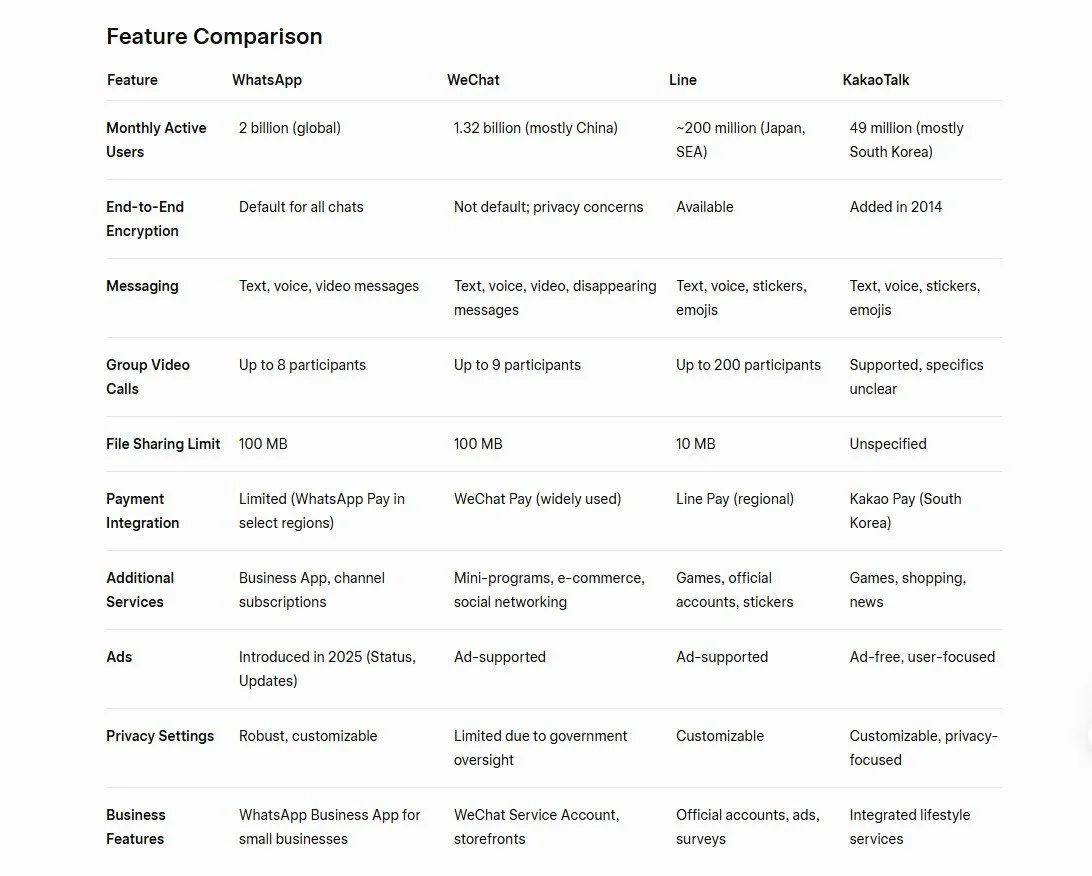Social Media Messenger: Development and Takeaway for Marketing
June 2025 marked a turning point: WhatsApp, the world’s largest messaging app, announced the introduction of ads in its Updates tab. This follows a decade-long pattern where messenger platforms slowly evolve from simple communication tools into marketing and business ecosystems. But WhatsApp’s move is just the latest in a broader trend. From WeChat’s super-app dominance in China to KakaoTalk’s lifestyle integration in Korea, messaging platforms now play a central role in how brands engage consumers — particularly in Asia.
This blog breaks down the development, features, and marketing potential of major messaging apps — including the enterprise-focused WeCom — and explores what this means for CRM and advertising strategies in 2025 and beyond.
Key Developments & Trends
🟢 WhatsApp (Meta)
2025: Launches ads in Status and Updates tab, promoting Channels and Business Profiles.
Robust end-to-end encryption, ideal for private CRM and transactional messaging.
WhatsApp Business API supports automation and chat-based support.
Not yet a commerce or payment hub in most regions.
Marketing Implication: Use WhatsApp for customer service, reminders, loyalty updates—not mass advertising. Leverage click-to-WhatsApp ads from FB/IG.
🟢 WeChat (Tencent)
China's all-in-one app: messaging, WeChat Pay, e-commerce, mini-programs.
Ads available via Moments and Official Accounts.
No default end-to-end encryption; regulated by the Chinese government.
Marketing Implication: Brands in China can use WeChat as a full-funnel platform—from awareness (ads) to conversion (mini-programs) to retention (messaging).
🟢 WeCom (Enterprise WeChat)
Tencent’s B2B-focused extension of WeChat, with CRM and workflow tools.
Connects employees to clients via verified accounts, while remaining compliant with Chinese regulations.
Key Features:
Strong API support for linking with Salesforce, Hubspot, and proprietary CRM systems.
Marketing Implication: For China-based enterprises, WeCom is the key to running regulated, compliant, and personalized CRM at scale. It merges internal communications with customer engagement—a powerful hybrid model.
🟢 Line (Japan, Thailand, Taiwan)
Pioneered stickers, gamified brand communication.
Offers Line Official Accounts for brand messaging.
Line Ads Platform (LAP) allows for precise targeting.
Offers Line Pay, Line Shopping, and branded mini-games.
Marketing Implication: Ideal for loyalty marketing and high-engagement CRM, especially in Japan. Brands can creatively engage via stickers, emojis, and digital collectibles.
🟢 KakaoTalk (Korea)
Fully integrated with Kakao Pay, shopping, gaming, and content.
Offers BizMessage, CRM messaging via KakaoTalk Channel.
Maintains an ad-free interface in the main chat stream.
Used for public service alerts, concert ticketing, and K-pop fandom.
Marketing Implication: Best for lifestyle brands and cultural tie-ins in Korea. CRM messages feel native due to deep integration with Korean daily life.
🟢 Telegram
Open platform with Channels, Groups, Bots, and Sponsored Messages.
Popular for influencer marketing, crypto communities, and broadcast content.
Limited formal CRM integration.
Marketing Implication: Use Telegram to build a brand-led or influencer-led community, especially for early-stage products, niche industries, or youth audiences.
Recent Updates
WhatsApp: Native macOS/Windows apps (2023), ads in Updates tab (2025).
WeChat: Continued expansion of mini-programs and WeChat Pay, with VoIP enhancements.
Line: Enhanced group call features and Line Pay adoption in Asia.
KakaoTalk: Strengthened Kakao Pay and lifestyle integrations, maintaining ad-free experience.
Ecosystem
WhatsApp: Its strength lies in simplicity, global reach, and robust encryption. The 2025 ad introduction suggests a pivot toward monetization, potentially emulating WeChat’s model, but its focus remains narrower (messaging and basic business tools).
WeChat: A super-app with unmatched multifunctionality, but its lack of default encryption and Chinese government oversight limit global appeal.
Line: Excels in engagement with stickers and large group calls, but its regional focus and smaller user base limit its global impact.
KakaoTalk: Dominates South Korea with a privacy-focused, ad-free experience, but its global presence is minimal.
Analysis
WhatsApp’s introduction of advertising in 2025 is a step toward a broader ecosystem, but it is unlikely to become the next WeChat in the near term. WeChat’s success as a super-app stems from its deep integration into daily life in China, where it faces little competition due to government bans on foreign apps.
WhatsApp, while globally dominant, lacks the extensive non-messaging features (e.g., mini-programs, comprehensive payment systems) that define WeChat. Its focus on privacy and simplicity contrasts with WeChat’s all-in-one approach, which may limit its ability to replicate WeChat’s model without alienating users. Line and KakaoTalk, while innovative in their regions, are too geographically constrained to challenge WhatsApp or WeChat globally. For WhatsApp to approach WeChat’s scope, Meta would need to significantly expand its ecosystem while navigating regulatory and user privacy concerns. Currently, WhatsApp’s trajectory suggests incremental growth rather than a full transformation into a super-app.
Strategic Takeaways
China strategy = WeChat + WeCom
WhatsApp is growing — but still utility-first
Line and KakaoTalk = creative loyalty ecosystems in APAC
As messaging apps evolve into ecosystems, marketers have a new mandate: become conversational, contextual, and culturally relevant. The platforms offer more than just communication — they offer attention, affinity, and action. But only if used thoughtfully. The future of CRM and advertising isn’t just about reaching inboxes or social feeds — it’s about showing up inside the conversations people care about.


